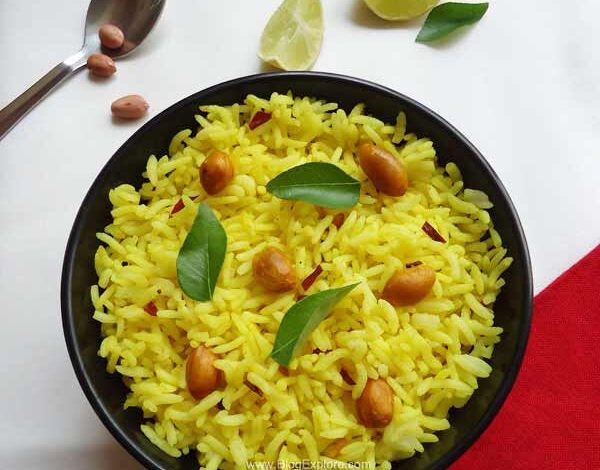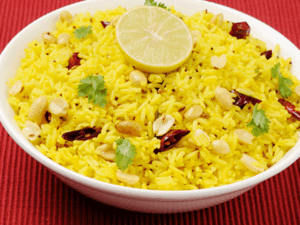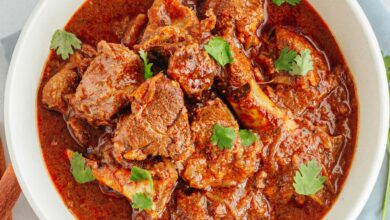Lemon Rice Recipe
Lemon Rice Recipe

Lemon Rice Recipe Introduction:
Lemon Rice is a popular South Indian dish known for its bright, tangy flavor and simplicity. This vibrant rice dish is infused with the refreshing zest of lemon and balanced with aromatic spices, making it a delightful and easy-to-make meal. Often enjoyed as a quick lunch or a flavorful side dish, Lemon Rice is both comforting and zesty. The recipe typically features mustard seeds, turmeric, and curry leaves, creating a harmony of flavors that complement the citrusy punch of lemon. It’s a great way to use up leftover rice and can be easily customized with additional ingredients like peanuts, chana dal, or vegetables. This dish not only pleases the palate but also adds a touch of color to any meal.

Lemon Rice Recipe Ingredients:
- 2 cups cooked rice (preferably cold or day-old rice; freshly cooked rice can also be used if cooled)
- 2 tablespoons vegetable oil (or any neutral oil like canola or sunflower oil)
- 1 teaspoon mustard seeds
- 1 teaspoon cumin seeds (optional, for added flavor)
- 1/4 cup chana dal (split chickpeas) (optional, adds crunch and texture)
- 1/4 cup peanuts (optional, for extra crunch)
- 2-3 green chilies, slit (adjust to taste for spice level)
- 1/2 teaspoon turmeric powder
- 1/2 teaspoon asafoetida (hing) (optional, for flavor)
- 10-12 curry leaves
- 1 tablespoon lemon juice (adjust to taste)
- Salt to taste
- Fresh coriander leaves, chopped (for garnish)
- 1 tablespoon grated coconut (optional, for added flavor)
Optional Add-ins:
- 1/2 cup finely chopped onions (for added flavor)
- 1/2 cup diced tomatoes (for a slight tanginess and color)
- 1/2 teaspoon sugar (optional, to balance the tanginess of the lemon)
Lemon Rice Recipe Ingredient Tips:
Rice:
- Use Day-Old Rice: Day-old rice or cold rice works best because it’s drier and less likely to clump together. Freshly cooked rice can also be used if allowed to cool completely before cooking.
- Texture: Ensure the rice grains are separate and not mushy for the best texture in your Lemon Rice.
Oil:
- Type of Oil: Use neutral oils like vegetable oil, canola oil, or sunflower oil. These oils won’t overpower the lemon flavor and will let the spices shine.
Mustard Seeds:
- Tempering: Mustard seeds add a nice crunch and nutty flavor. Ensure the oil is hot before adding them to prevent burning and achieve the best flavor.
Cumin Seeds:
- Optional: Cumin seeds add a warm, earthy flavor. If you like the taste of cumin, include it; otherwise, it can be omitted.
Chana Dal (Split Chickpeas):
- Texture and Flavor: Chana dal adds crunch and a slightly nutty flavor. Lightly toast them in the oil before adding the rice to enhance their flavor and texture.
Peanuts:
- Roasting: Use raw peanuts or roasted peanuts. If using raw peanuts, roast them in the pan until they are golden brown and crunchy. This adds texture and flavor to the rice.
Green Chilies:
- Spice Level: Adjust the number of green chilies based on your spice tolerance. For less heat, you can slit the chilies and remove the seeds before adding them to the pan.
Turmeric Powder:
- Flavor and Color: Turmeric gives Lemon Rice a beautiful golden color and a subtle earthy flavor. Ensure it’s well mixed into the rice to distribute its flavor evenly.
Asafoetida (Hing):
- Flavor Profile: Asafoetida adds a unique flavor, often described as a mix of onion and garlic. Use it sparingly as it can be potent. If you don’t have it, you can skip it or substitute with a small amount of garlic or onion.
Curry Leaves:
- Freshness: Fresh curry leaves provide a distinctive aroma and flavor. If you can’t find fresh curry leaves, you can use dried ones or omit them if necessary.
Lemon Juice:
- Adjust to Taste: Start with 1 tablespoon of lemon juice and adjust according to your taste preference. Adding it just before serving ensures the flavor remains fresh and tangy.
Salt:
- Seasoning: Add salt to taste and consider the saltiness of any additional ingredients (like peanuts or chana dal) when seasoning.
Optional Ingredients:
- Onions: If using onions, cook them until they are translucent before adding them to the rice. This adds sweetness and depth of flavor.
- Tomatoes: If using tomatoes, add them after sautéing the onions and cook until they are soft and slightly caramelized.
- Grated Coconut: Fresh or desiccated coconut adds a nice texture and flavor. Add it at the end for a bit of extra richness.
General Tips:
- Mixing: Gently mix the rice with the spices to avoid breaking the rice grains.
- Garnishing: Garnish with fresh coriander leaves or a few extra peanuts for added color and texture.
Lemon Rice Recipe Equipment Needed:
Essential Equipment:
- Pan or Skillet:
- Wok or Large Skillet: Ideal for stir-frying the rice and mixing it with spices. A large pan ensures there’s enough room to mix the rice thoroughly without overcrowding.
- Alternative: A medium-sized saucepan can also work if you don’t have a wok or large skillet.
- Cooking Utensils:
- Wooden Spoon or Spatula: For stirring and mixing the rice and spices. A wooden spoon is gentle on non-stick surfaces, while a heat-resistant spatula can be used for scraping and mixing.
- Knife and Cutting Board:
- Knife: For chopping vegetables like green chilies, onions, or tomatoes, if using.
- Cutting Board: A clean surface for chopping and prepping your ingredients.
- Measuring Spoons:
- Measuring Spoons: For accurately measuring spices, lemon juice, and other small quantities.
- Mixing Bowl:
- Bowl: Useful for mixing spices or holding prepped ingredients before adding them to the pan.
- Lemon Juicer (Optional):
- Juicer: Helps extract juice from lemons efficiently and can be used to get the most out of the lemon.
- Colander or Sieve (Optional):
- Colander: If you need to rinse or drain any ingredients, such as if you’re using fresh herbs or washing vegetables.
Optional Equipment:
- Rice Cooker:
- Rice Cooker: If you’re cooking rice from scratch, a rice cooker can be convenient for cooking perfect rice. If using leftover rice, this isn’t necessary.
- Grater (Optional):
- Grater: If you’re using fresh coconut, a grater can be useful for shredding it.
- Garlic Press (Optional):
- Garlic Press: If you’re adding garlic, a press can help mince it quickly and easily.
Tips:
- Preheat the Pan: Ensure your pan or skillet is preheated before adding oil and spices to achieve the best flavor and texture.
- Cook in Batches: If making a large quantity, consider cooking in batches to avoid overcrowding the pan and to ensure even mixing and cooking.
Lemon Rice Recipe Step-by-Step Instructions:
- Prepare the Rice:
- Step 1: If using freshly cooked rice, spread it out on a tray to cool completely. Cold or day-old rice works best for fried rice dishes like Lemon Rice. This helps prevent clumping.
- Heat Oil:
- Step 2: Heat 2 tablespoons of vegetable oil in a large pan or skillet over medium heat.
- Add Tempering:
- Step 3: Once the oil is hot, add 1 teaspoon of mustard seeds. Allow them to splutter.
- Step 4: If using, add 1 teaspoon of cumin seeds to the pan and let them sizzle briefly.
- Sauté Dal and Peanuts:
- Step 5: Add 1/4 cup of chana dal (split chickpeas) and 1/4 cup of peanuts to the pan. Sauté until the dal turns golden brown and the peanuts become slightly roasted, about 2-3 minutes.
- Add Spices and Aromatics:
- Step 6: Add slit green chilies and 1/2 teaspoon of turmeric powder. Stir and cook for about 30 seconds to release the spices’ aroma.
- Step 7: If using, add 1/2 teaspoon of asafoetida (hing) and mix well.
- Add Curry Leaves:
- Step 8: Add 10-12 curry leaves to the pan. Sauté for another 30 seconds. Be careful as the curry leaves may splutter in hot oil.
- Mix in Rice:
- Step 9: Add the cooked rice to the pan. Gently mix the rice with the tempering ingredients, making sure the spices are evenly distributed. Stir gently to avoid breaking the rice grains.
- Add Lemon Juice:
- Step 10: Pour 1 tablespoon of lemon juice over the rice. Mix well. Taste and adjust the lemon juice if needed to achieve the desired tanginess.
- Season and Garnish:
- Step 11: Add salt to taste and mix thoroughly.
- Step 12: If using, add 1 tablespoon of grated coconut for extra flavor. Mix gently.
- Step 13: Garnish with freshly chopped coriander leaves.
- Serve:
- Step 14: Serve hot as a main dish or as a side. Lemon Rice pairs well with yogurt, pickles, or as part of a larger meal with other Indian dishes.
Tips:
- Adjust Spice Level: Modify the number of green chilies based on your preference for spiciness.
- Cool Rice First: If using fresh rice, ensure it’s cooled to prevent clumping.
- Serve Immediately: Lemon Rice is best enjoyed fresh, but it can be kept in an airtight container in the refrigerator for a day or two.
Tips and Tricks:
Tips for Perfect Lemon Rice:
- Use Day-Old Rice:
- Why: Day-old rice is drier and less likely to clump, making it ideal for stir-frying. If using freshly cooked rice, let it cool completely to avoid mushiness.
- Preheat the Pan:
- Why: A hot pan ensures that the spices and tempering ingredients are properly toasted and aromatic. It also helps achieve a good texture for the rice.
- Avoid Overcrowding:
- Why: Cooking in batches if necessary ensures even distribution of spices and prevents the rice from steaming rather than frying. This helps maintain the rice’s texture.
- Proper Tempering:
- Why: Tempting spices like mustard seeds and cumin seeds at the right temperature brings out their full flavors. Add them when the oil is hot but not smoking.
- Sauté Dal and Peanuts Until Golden:
- Why: Chana dal and peanuts add crunch and texture. Sauté until golden brown to enhance their flavor and avoid a raw taste.
- Adjust Spice Level:
- Why: Green chilies can vary in heat. Start with fewer chilies and adjust according to your spice tolerance. Remove seeds for less heat.
- Add Lemon Juice Last:
- Why: Adding lemon juice towards the end preserves its fresh, tangy flavor. Adjust the amount based on your taste preference.
- Include Optional Ingredients:
- Why: Ingredients like grated coconut or diced tomatoes can add extra flavor and texture. Customize your Lemon Rice by adding these if desired.
- Mix Gently:
- Why: Gently mix the rice to avoid breaking the grains and to ensure an even distribution of spices.
- Taste and Adjust:
- Why: Always taste before serving. Adjust salt, lemon juice, or spices to suit your taste.
Tricks for Enhanced Flavor:
- Add Fresh Herbs:
- Why: Fresh coriander leaves add a burst of freshness and color. Garnish just before serving for the best flavor and appearance.
- Use Fresh Curry Leaves:
- Why: Fresh curry leaves impart a unique aroma and flavor. If fresh ones aren’t available, use dried curry leaves or skip them if necessary.
- Incorporate Additional Vegetables:
- Why: Adding finely chopped vegetables like carrots or bell peppers can increase nutritional value and add color. Sauté them along with the tempering.
- Balance the Tanginess:
- Why: If the lemon juice is too tangy, balance it with a small pinch of sugar to mellow the flavors.
- Use a Wok or Heavy Pan:
- Why: A wok or heavy pan provides better heat distribution and prevents sticking, making it easier to stir-fry the rice evenly.
- Avoid Overcooking:
- Why: Overcooking can make the rice mushy. Cook just long enough to mix in the flavors and heat through.
- Serve Immediately:
- Why: Lemon Rice is best enjoyed fresh. If storing leftovers, reheat gently to avoid drying out the rice.
Serving Suggestions:
Lemon Rice is a versatile dish that pairs well with a variety of accompaniments. Here are some delicious serving suggestions to complement your Lemon Rice:
- With Yogurt:
- Plain Yogurt: A simple side of plain yogurt or raita (yogurt mixed with chopped vegetables and spices) provides a cooling contrast to the tangy Lemon Rice.
- Cucumber Raita: A refreshing cucumber raita adds crunch and balances the flavors.
- With Pickles:
- Indian Pickles: Serve with spicy or tangy Indian pickles like mango pickle, lime pickle, or mixed vegetable pickle for an extra kick of flavor.
- Chutneys: Try a side of coconut chutney or mint chutney for added freshness.
- With Papadam or Crisps:
- Papadam: Crispy papadams or roasted Indian crisps add a delightful crunch and are perfect for scooping up the rice.
- Potato Chips: For a more casual option, serve with potato chips for added crunch.
- With Curry or Dal:
- Vegetable Curry: A mild or spicy vegetable curry complements the tanginess of Lemon Rice beautifully.
- Dal (Lentil Soup): Serve with a simple dal or sambar for a wholesome and comforting meal.
- As Part of a Thali:
- Indian Thali: Include Lemon Rice as one of the components in a traditional Indian thali, along with dal, vegetable curry, chapati or naan, and a sweet or tangy side.
- With Roasted or Grilled Meat:
- Chicken or Fish: Lemon Rice pairs well with grilled or roasted chicken, fish, or any other meat. The citrusy flavor enhances the overall meal.
- With Fresh Salad:
- Simple Salad: Serve with a fresh salad made of tomatoes, cucumbers, onions, and herbs for a light and healthy addition.
- Kachumber Salad: A traditional Indian salad of diced vegetables mixed with lemon juice and spices.
- With a Side of Vegetables:
- Stir-Fried Vegetables: Complement the rice with a side of stir-fried vegetables for a balanced and colorful meal.
- Saag (Spinach) or Bhindi (Okra): Indian-style saag or bhindi make great side dishes.
- With a Side of Raita:
- Boondi Raita: A yogurt-based side with crispy boondi (fried chickpea flour balls) adds a delicious texture.
- Onion and Tomato Raita: Simple and refreshing, this raita adds a tangy flavor.
- In a Bento Box:
- Japanese-Inspired: Include Lemon Rice in a bento box along with a variety of items like grilled meat, vegetables, and a small portion of fruit.
- With Steamed or Grilled Fish:
- Grilled Fish: Serve with a side of grilled fish for a healthy and satisfying meal.
- Tandoori Fish: Spiced tandoori fish pairs excellently with the zesty rice.
- As a Light Snack:
- Lemon Rice Wrap: Wrap Lemon Rice in a roti or tortilla for a quick and tasty snack or lunch option.
These serving suggestions enhance the tangy and flavorful profile of Lemon Rice and make it suitable for various meals and occasions. Enjoy experimenting with different pairings to find your favorite combination!
FAQs:
1. Can I use freshly cooked rice for Lemon Rice?
Answer: Yes, you can use freshly cooked rice, but it’s best to let it cool completely before using it. Freshly cooked rice can be a bit sticky, so spreading it out on a tray or allowing it to sit for a while helps it dry out slightly and makes it easier to stir-fry without clumping.
2. How can I adjust the tanginess of Lemon Rice?
Answer: The tanginess can be adjusted by varying the amount of lemon juice. Start with 1 tablespoon and taste as you go. If it’s too tangy, you can balance it with a small pinch of sugar or a little extra cooked rice to dilute the acidity. Adjust the lemon juice to your taste preference before serving.
3. What can I substitute for curry leaves if I don’t have them?
Answer: If you don’t have curry leaves, you can skip them or use dried curry leaves if available. For a different flavor profile, you can use a small amount of basil or oregano, though they won’t replicate the exact taste of curry leaves. Asafoetida (hing) can also add a unique flavor if you’re out of curry leaves.
4. How can I make Lemon Rice spicier or milder?
Answer: To make Lemon Rice spicier, increase the number of green chilies or add a pinch of red chili powder or cayenne pepper. For a milder flavor, use fewer green chilies or remove the seeds from the chilies before adding them. Adjust the spice level to your preference during cooking.
5. Can I make Lemon Rice ahead of time? How do I store and reheat it?
Answer: Yes, you can make Lemon Rice ahead of time. Store it in an airtight container in the refrigerator for up to 2-3 days. To reheat, use a microwave or gently reheat in a pan with a splash of water or oil to prevent it from drying out. Stir well to ensure even heating. You can also freshen it up with a little extra lemon juice before serving.





